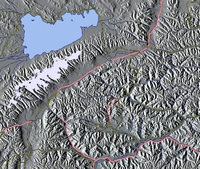
Photo from wikipedia
Abstract The paleogeographic evolution of the Lhasa Block in northern Tibet during the Permian has been a contentious issue during the past decades. Several pioneering studies have highlighted the significance… Click to show full abstract
Abstract The paleogeographic evolution of the Lhasa Block in northern Tibet during the Permian has been a contentious issue during the past decades. Several pioneering studies have highlighted the significance of faunas and their paleobiogeography in this block. In this paper, a new Middle Permian foraminiferal fauna is documented from the Xiala Formation in the Zhabuye area in the central Lhasa Block. This fauna is characterized by the presence of the Shanita-Hemigordiopsis foraminiferal assemblage, with its age to be the early Midian (Wordian) based on the coexisting fusulines Neoschwagerina craticulifera (Schwager), N. cheni Sheng and Kahlerina tenuitheca Wang, Sheng and Zhang. A review of the Shanita-Hemigordiopsis assemblage globally confirms that the age of this assemblage ranges from the late Murgabian to the Midian rather than extending into the Dzhulfian as previously recognized. This assemblage is widely distributed on the Cimmerian microcontinents and Gondwanan margin, but absent from the South China and Indochina blocks, which were approximately at the same latitude with Turkey in equatorial regions. Such a distribution pattern is better explained by the influence of oceanic currents flowing from equatorial regions to the Gondwanan margin along the Neotethys Ocean. It further suggests that the Neotethys Ocean may have opened by the Middle Permian to facilitate oceanic currents.
Journal Title: Palaeogeography, Palaeoclimatology, Palaeoecology
Year Published: 2021
Link to full text (if available)
Share on Social Media: Sign Up to like & get
recommendations!